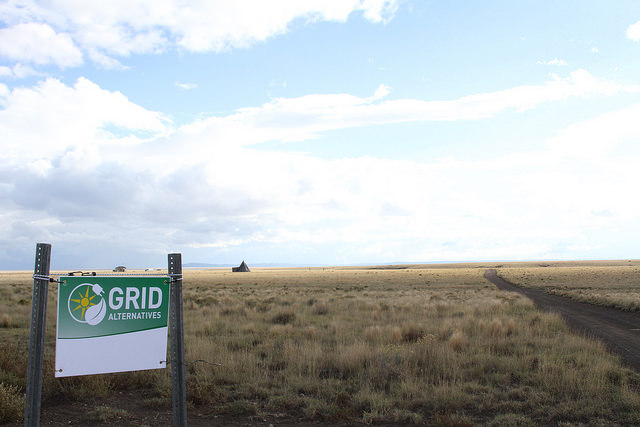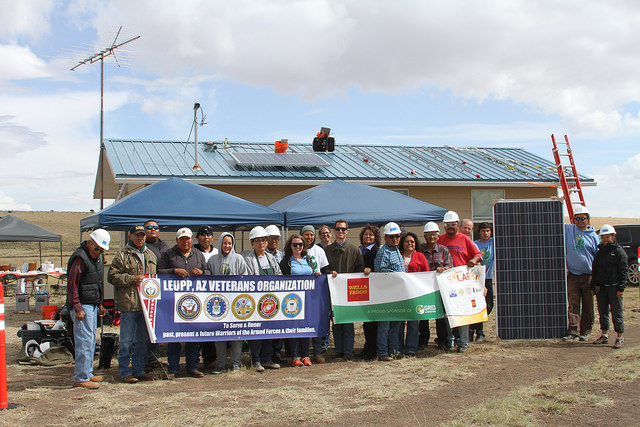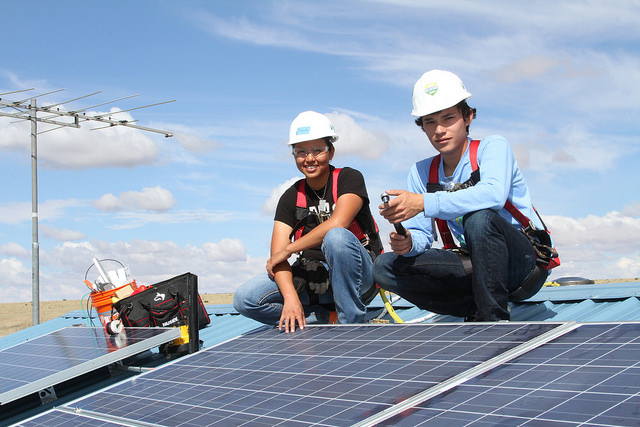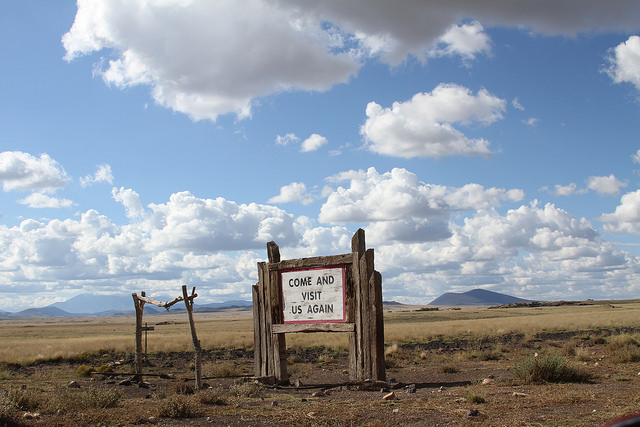Driving across the Navajo Nation in northern Arizona, you can’t help but notice the vast openness. Yellow brush and dried grasses spread for miles across the plateau. Off in the distance loom the San Francisco Peaks -- named Doko’oosliid in Navajo -- mountains sacred to the tribe.
The nation crosses three states and covers an area the size of West Virginia, and the wide stretches of sparsely populated land can make it feel like you’ve stepped back into the past. For residents here, that remoteness comes with a price. Everything is a drive, and services are few and far between: Only 10 grocery stores serve the entire reservation. Perhaps most surprising about the state of life in 21st-century Navajo territory is that many of the residents live without electricity.
An estimated 15,000 homes across the Navajo Nation have never been connected to the grid. Many of the newer ones have been fully wired: they’ve got light fixtures and switches, and all the wires and panels are in place, but the grid doesn’t reach them -- any electricity they use comes from gas-powered generators. The slow pace of progress comes down to the high costs of expanding the grid. It can cost the Navajo Tribal Utility Authority as much as $50,000 to extend electrical service by just one mile.
 This week, as part of our national Tribal Solarthon, GRID Alternatives demonstrated one way to begin addressing this gap: off-grid solar. In partnership with the Leupp, Tolani Lake, and Bird Springs Chapter Houses, GRID installed a 1.4-kilowatt, battery-based solar system on the home of Henry Yazzie, a Navajo Vietnam Veteran. Mr. Yazzie grew up without electricity, and has relied on a generator since his current home was built for him two years ago by local Navajo veterans from the Western Agency. Navajo volunteers, job trainees and family members came from all over to help with the solar installation.
This week, as part of our national Tribal Solarthon, GRID Alternatives demonstrated one way to begin addressing this gap: off-grid solar. In partnership with the Leupp, Tolani Lake, and Bird Springs Chapter Houses, GRID installed a 1.4-kilowatt, battery-based solar system on the home of Henry Yazzie, a Navajo Vietnam Veteran. Mr. Yazzie grew up without electricity, and has relied on a generator since his current home was built for him two years ago by local Navajo veterans from the Western Agency. Navajo volunteers, job trainees and family members came from all over to help with the solar installation.
His system is relatively small, but its impacts will be priceless. Not only will the system allow him to power his lights, television, and other appliances, but it will free him from the environmental and financial costs of his generator.
Mr. Yazzie went to Vietnam in 1968, and according to his sister Lorraine, he “never really came back.” He is a quiet man who speaks primarily Navajo; he suffers from PTSD and has always struggled to re-adjust to life back home. Until the group of veterans and volunteers built his home two years ago, Henry lived in a tiny trailer on the property.
"Henry's just so overwhelmed -- he never thought this would be possible, to get all of this stuff free of charge,” said Gilbert Chee, the Western Navajo Agency Commander. “He is thankful for all his fellow veterans and just really thankful right now."
Chee, who is also a veteran, feels strongly about the importance of supporting other veterans. "To me this is gratifying. It's about time we do something for our veterans,” Mr. Chee said. “You guys are the first to step up and offer your help and assistance in this way and we appreciate it very much."
 Mr. Yazzie’s sister is optimistic that the new solar system will improve her brother’s situation. “I’m so happy for him to get electricity,” Lorraine says. “I hope that being able to watch TV, listen to his radio and have lights will help Henry live a happier life.”
Mr. Yazzie’s sister is optimistic that the new solar system will improve her brother’s situation. “I’m so happy for him to get electricity,” Lorraine says. “I hope that being able to watch TV, listen to his radio and have lights will help Henry live a happier life.”
This installation marks GRID Alternatives’ first battery-backed system on tribal territory, and we are excited about the promise that battery-backed systems offer to rural areas of the Navajo Nation. Not only does off-grid solar free families from generators, coal and other polluting and expensive energy sources, but it also saves cash-strapped tribes the significant amounts of time and money it would otherwise take to bring electricity to their residents.
For Tim Willink, GRID Alternatives’ Director of Tribal Programs, helping make this installation happen has been something of a homecoming. Mr. Willink is Navajo, and remembers clearly what it was like growing up with no electricity.
“My family’s house was built 25 years ago by Tribal Housing, and it has always had a refrigerator -- but when you open it, it’s filled with blankets and towels,” he said. “That fridge has never been used for food.”
“A lot of Navajo use kerosene lamps for lighting,” said Mr. Willink. “I grew up with those lamps and still have a nostalgia for them, but when you learn about the health consequences, it becomes a serious issue.” In addition to much higher risks of fire and poisoning, fuel-based lighting exposes residents to much higher levels of particulate pollution, which can cause respiratory illnesses and even lung cancer.
 Solar has another benefit for the Navajo as it becomes more widespread: Job opportunities. Teracita Martinez, a young Navajo veteran, drove three hours from her home in New Mexico to join in the installation. She said it has been an honor to be a part of the project.
Solar has another benefit for the Navajo as it becomes more widespread: Job opportunities. Teracita Martinez, a young Navajo veteran, drove three hours from her home in New Mexico to join in the installation. She said it has been an honor to be a part of the project.
“Growing up on the reservation, college is not a huge part of your mindset because of income,” she said. “Most young people have to take care of their families, so it’s kind of hard to just leave to go to college and not know if your elders are going to be OK. So getting involved with solar is a way to learn skills and have options to stay.”
"Solar is the future and is what we want,” said Valerie Kelly, a member of the Leupp Chapter and the Community Services Coordinator for the Tolani Lake Chapter. “I want my youth, my teenagers, the younger generation to learn solar so that when they go out they will have these skills."
Training local residents in installation also helps GRID ensure that the systems will be able to be maintained. It is not uncommon to find non-working solar systems on homes on the reservation, systems that have failed over time because no one was trained to keep them running. GRID is currently seeking funding to rehabilitate 36 systems for Navajo families, as well as install new systems on two additional homes.
Check out more photos from the event here.
****
 From September 28 to October 9, GRID Alternatives is partnering with four Native American tribes in four states for our Tribal Solarthon, providing solar power and solar job training to tribal residents and putting a spotlight on energy and economic issues in their communities. GRID has partnered with over 30 tribes since 2010, installing solar electric systems for more than 330 tribal member families—1.5 MW of clean power—and trained nearly 200 tribal members in solar installation. We formally launched our national tribal program in 2014 with a long-term goal of building permanent infrastructure to make solar power and job training accessible to tribal communities throughout the US.
From September 28 to October 9, GRID Alternatives is partnering with four Native American tribes in four states for our Tribal Solarthon, providing solar power and solar job training to tribal residents and putting a spotlight on energy and economic issues in their communities. GRID has partnered with over 30 tribes since 2010, installing solar electric systems for more than 330 tribal member families—1.5 MW of clean power—and trained nearly 200 tribal members in solar installation. We formally launched our national tribal program in 2014 with a long-term goal of building permanent infrastructure to make solar power and job training accessible to tribal communities throughout the US.
The Solarthon event is sponsored by Wells Fargo Foundation through a five-year, $2 million national expansion grant awarded to GRID Alternatives in 2012. Additional funders include the Department of Energy and GRID Alternatives equipment partners SunEdison, SunPower Corp., Enphase Energy, SnapNrack and IronRidge.
